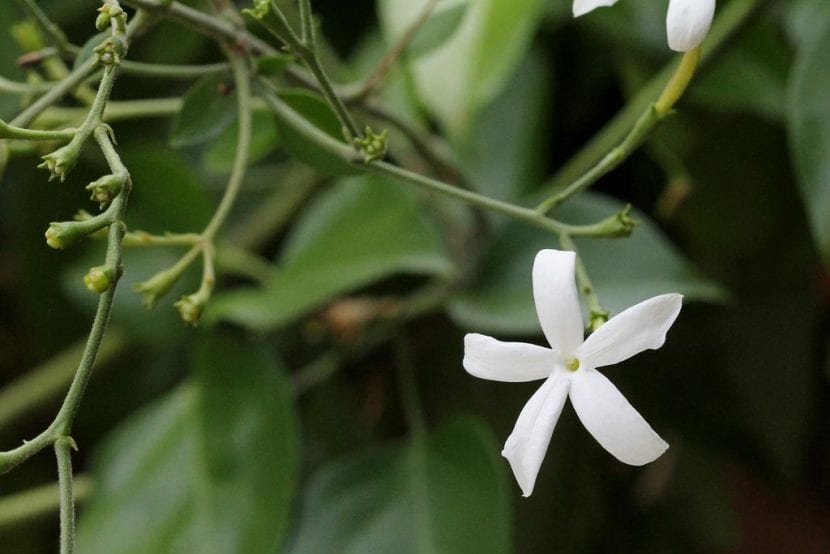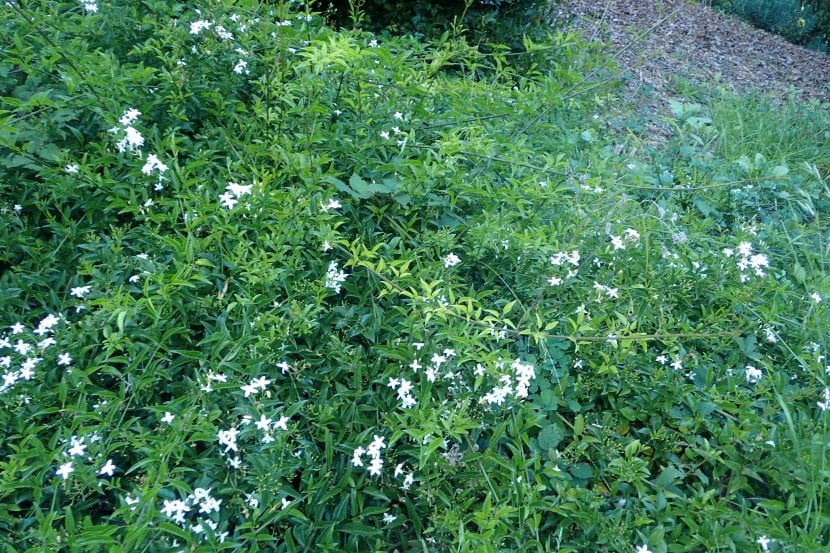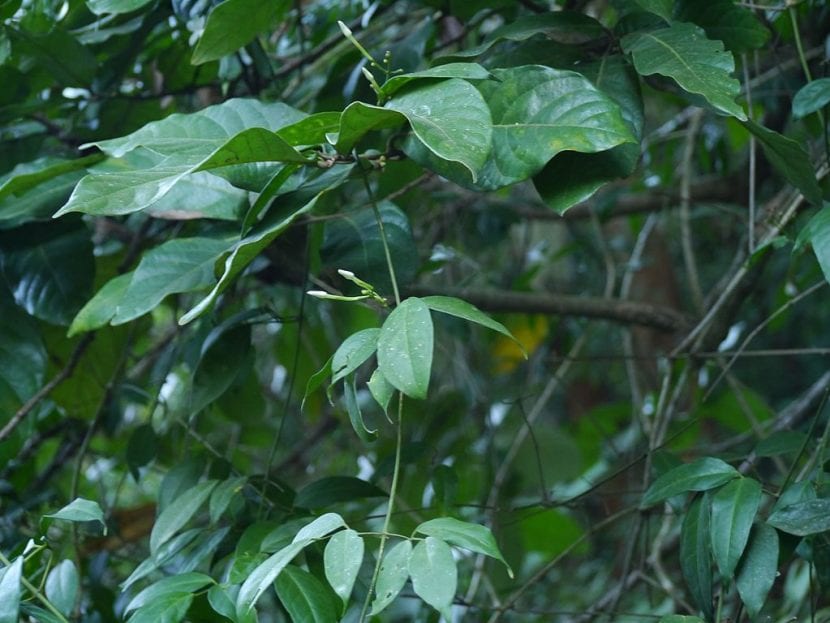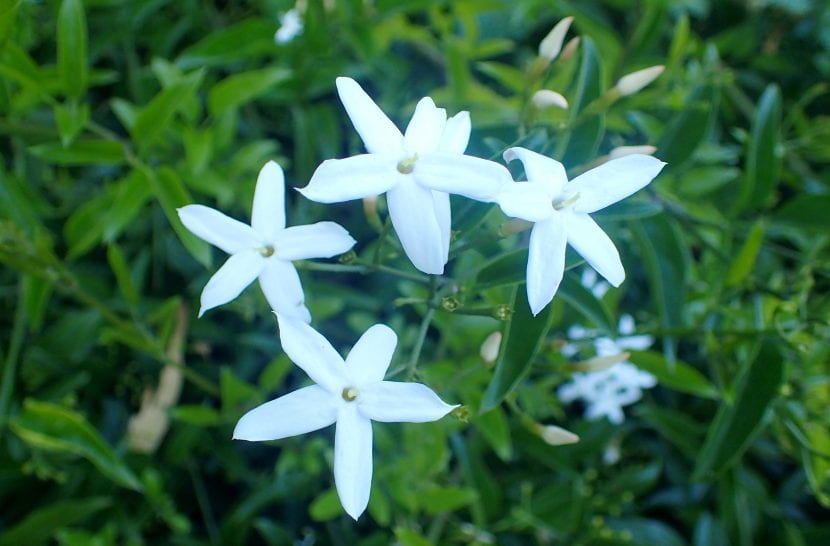
Image - Flickr / Mauricio Mercadante
El Jasminum azoricum It is a beautiful climbing plant that you can have in small gardens or even in pots. Its maintenance is simple, since it only needs to be watered from time to time and a warm or temperate climate to be in perfect condition.
So if you want to know how to enjoy it, then I am going to tell you what care you need 🙂.
Origin and characteristics of Jasminum azoricum

Image - Wikimedia / Krzysztof Ziarnek, Kenraiz
Known as Azores jasmine, azoric jasmine, or lemon-scented jasmine, it is a climbing, evergreen (meaning it remains evergreen) native to the island of Madeira. It can reach a maximum height of 5-6 meters if it has some support to climb, like the trunk of a tree, a lattice, wall, or etcetera. The leaves are composed of three green leaflets which are about 3 centimeters long.
The flowers, which sprout throughout the spring, are grouped in terminal racemes, and are composed of four white petals that they give off a very pleasant aroma. For its beauty and scent, in the UK it won the Garden Award of Merit, from the Royal Horticultural Society.
It is a critically endangered species in its place of origin. It is only known that there are two natural populations of between 6 and 50 plants in the Funchal area and in the Ribeira Brava area. More information here. Its production for use as an ornamental plant is allowed.
What are their cares?
If you want to have a copy, we recommend that you provide it with the following care:
Location
It is a plant that must be in full sun, or in semi-shade, in an area where it receives more hours of light than shade. In climates such as the Mediterranean it is advisable to have it a little protected from the star king.
Earth

Image - Wikimedia / Dinesh Valke
It will depend on where you have it:
- Flower pot: fill it with a mixture of 50% universal substrate (for sale here) with 40% perlite (for sale here) or similar and 10% worm castings (for sale here).
- Garden: grows in soils rich in organic matter, with good drainage.
Irrigation
The frequency of irrigation will be moderate. In general, and depending on the climate in your area, you should water an average of about 4 times a week during the hottest and driest time of the year, and about 2 times a week the rest of the year.
When you water make sure of the following:
- If it is potted:
- The water must penetrate the substrate; I mean, you don't have to go sideways. If this happens, it is because it is not of very good quality since when it dries completely it compacts so much that it looks like a 'block' of earth. To rehydrate it, you have to take the pot and put it in a basin of water for about 30-40 minutes.
- The water should come out of the drainage holes.
- If it is on the ground:
- It is advisable to make a tree around it so that the water stays close to the plant. A tree grate is like a low height barrier (about 3-5 centimeters) made with the same soil - sometimes stones are used as well - from the garden.
- Water at dusk, especially in summer, to prevent water from being lost to evaporation.
In any case, when you water, do not wet the leaves as otherwise they could burn and / or rot.
Subscriber
From early spring to late summer it is advisable to pay at Jasminum azoricum with fertilizers such as guano (for sale here), which is natural and very quickly effective, or with others such as universal fertilizer (for sale here) or cow dung (for sale No products found.).
It is necessary to follow the instructions specified on the package in order to avoid the risk of overdose.
Pruning
Late winter You have to cut dry, diseased, weak stems and those that are broken. It is also advisable to trim those that are growing too much, especially if the plant is near or next to passageways.
Use for them pruning shears previously disinfected with pharmacy alcohol.
Planting or transplanting time
You can plant your climber in the garden or move it to a larger pot in spring, when the risk of frost has passed and the minimum temperature begins to be pleasant (about 15ºC or more).
Multiplication
Azores jasmine is multiplied by cuttings and shoots. Let us know how to proceed in each case:
Cuttings
Semi-hardwood cuttings with leaves are taken in late summer. These must measure at least 20-30 centimeters, and their base must be impregnated with rooting hormones (for sale here).
They are then planted in pots with vermiculite (for sale here) previously moistened, and left in an area protected from the sun.
Young
The suckers they separate from the mother plant in spring, or in autumn if the weather is mild or frost-free, with the help of a small hoe and pruning shears or a small saw. When they are separated, rooting hormones or homemade rooting agents, and finally they are planted in individual pots with vermiculite.
Rusticity

Image - Wikimedia / Krzysztof Ziarnek, Kenraiz
It resists frosts of up to -5ºC, but only if they are short-lived and punctual.
Enjoy your plant 🙂.